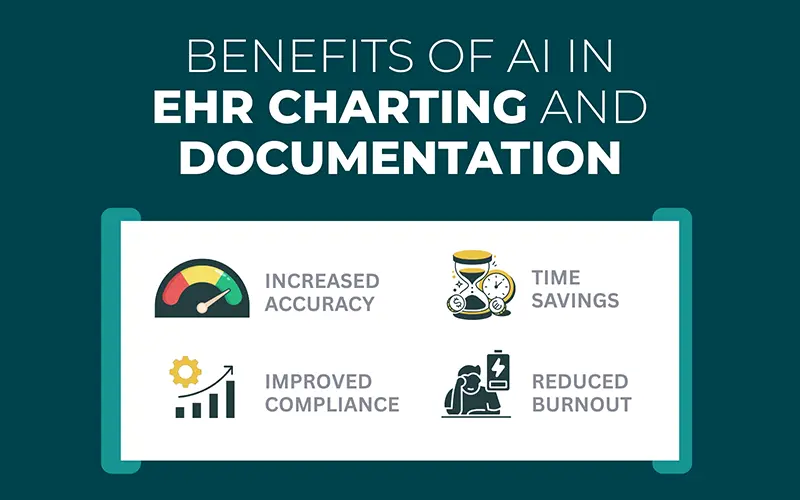
Table of Contents
Healthcare provider burnout due to electronic health record (EHR) documentation is an increasing concern. Time-consuming data entry takes physician focus away from direct patient care, raises the risk of medical errors, and can lower patient satisfaction. Traditional solutions-such as medical dictation services, workflow improvements, and staff training-offer some relief, but the adoption of AI in clinical documentation supported by technology-driven medical transcription services is transforming the process. This post explores how AI is transforming electronic health record documentation and reducing clinician burnout.
How AI in EHR Documentation is Revolutionizing Healthcare Workflows
Traditional clinical documentation presents major challenges for healthcare providers. Manual data entry and paperwork are tedious and time-consuming. A 2023 study titled ‘Burnout Related to Electronic Health Record Use in Primary Care’ found that physicians spend approximately 49.2% of their clinic day on EHR and desk work, leaving only 27% of their time for direct patient care. The repetitive nature of EHR data entry tasks increases the risk of errors, from missing details to inaccurate entries, which can impact patient safety and compliance. Traditional clinical charting also contributes to provider frustration and burnout, as clinicians spend hours completing administrative tasks instead of focusing on patient outcomes. Streamlining documentation is critical for improving both efficiency and the overall healthcare experience.
Clinical documentation automation is transforming EHR data entry by making it faster and more accurate. AI-powered EHR documentation tools can:
- Efficiently convert physician dictation to text
- Reduce transcription turnaround times
- Streamline clinical workflows
- Enhance medical record accuracy, and
- Free up healthcare providers’ valuable time for patient care.
Let’s take a closer look at the benefits of AI in EHR charting and documentation:

- Real-Time Clinical Documentation
AI tools for efficient patient charting in hospitals typically use ambient sensing and advanced natural language processing (NLP) to create real-time notes during patient-provider conversations, promoting physician focus on direct patient care. Often called an AI medical scribe, the technology listens to the physician-patient dialogue, processes information for orders and prescriptions, and automatically generates detailed, structured notes for the patient’s EHR. What takes hours when done manually takes just minutes with AI. AI assistants can reduce a physician’s time spent on documentation by up to 70%, according to a 2023 Google Scholar article.
- Seamless EHR Integration for Physician Workflow Optimization
AI transcription and AI scribing tools seamlessly integrate with EHR systems to automate clinical documentation, improve efficiency, and reduce administrative burdens for healthcare providers. By eliminating the need for manual data entry, this integration streamlines workflow and leads to faster access to updated patient records for the entire care team.
The system structures the information into a clinical note, often using templates like the SOAP (Subjective, Objective, Assessment, Plan) format. The structured note is sent to the EHR via secure channels, ensuring data security and compliance with HIPAA and other regulations. The transcribed data automatically populates the appropriate sections of the patient’s record. This can include pulling in relevant information like medical history or lab results.
- Reduced Administrative Burden
Excessive documentation is a major driver of physician burnout. AI-powered tools help ease this burden by automating clinical note generation, allowing physicians to focus more on patient care. Rather than spending hours on manual EHR data entry, providers can now simply review, make quick edits, and sign off on AI-generated notes directly within the EHR, enhancing efficiency, job satisfaction, and retention. One study found that clinicians using speech recognition (SR) completed their documentation in just 5.11 minutes on average, compared to 8.9 minutes when using traditional typing methods.
- Error Detection
AI in EHR documentation enhances accuracy and compliance by automatically identifying inconsistencies, missing details, or potential coding errors. For instance, when a physician documents a patient visit and notes a diagnosis of Type 2 diabetes, the AI system may flag a possible issue-detecting an ICD-10 coding mismatch based on the note’s content and suggesting a more precise code. This proactive error detection ensures clinical accuracy, supports proper reimbursement, and maintains adherence to documentation standards.
- Alerts and Predictions
Traditional EHRs generate alerts based on preset rules when patient data meets specific criteria, often requiring manual review. AI-powered predictive models go a step further by analyzing vast amounts of data to detect subtle patterns that indicate potential risks. These systems can identify high-risk conditions, such as sepsis or heart failure before symptoms become severe. This enables earlier intervention, improved outcomes, and more efficient patient management.
- Enhanced Patient Care
AI-powered healthcare documentation enhances patient care by freeing physicians from time-consuming documentation tasks and enabling them to focus more on direct patient interaction. By accurately converting voice recordings into structured clinical notes in real time, AI ensures that patient information is captured comprehensively and promptly. This leads to better-informed clinical decisions, fewer errors, and more coordinated care. AI transcription tools also support continuity of care by allowing every member of the healthcare team to access up-to-date patient records, driving better outcomes and patient satisfaction.
- Flawless Transcription Anywhere
From emergency rooms to operating rooms, these advanced AI transcription systems are designed to perform accurately even in the most challenging clinical environments. Whether it’s a busy emergency room filled with background noise or an operating theater with multiple speakers, these tools can distinguish voices, filter out ambient sounds, and transcribe conversations with exceptional clarity. This ensures that no critical detail is lost, supporting precise, real-time documentation and helping clinicians maintain complete and reliable medical records in high-pressure settings.
- Accurate and Reliable Medical Records
AI in EHR documentation enhances both the quality and reliability of clinical documentation. AI transcription helps ensure that patient records are both accurate and complete. By using advanced SR and NLP, these tools capture every clinical detail from physician dictations with exceptional precision. They minimize errors caused by manual entry or missed information, producing thorough and structured documentation. Accurate, complete records not only support better diagnosis and treatment decisions but also improve communication among care teams and strengthen compliance with regulatory standards.
Why Medical Transcription Outsourcing Remains Significant
While AI offers promising advancements to improve and speed up clinical documentation, it is not without challenges. Even AI systems with high accuracy rates, can make mistakes in medical transcription, ranging from simple errors to serious ones.
AI voice-to-text dictation can struggle with accents or complex medical terminology. Here are some examples:
- AI may transcribe a word with a different meaning that sounds similar to the one that was spoken. One AI reportedly mistook “MRI imaging” for “hemorrhaging,” creating serious errors.
- AI can struggle with medical jargon and abbreviations, potentially recording them incorrectly. A physician dictates: “The patient presents with choledocholithiasis and underwent ERCP with sphincterotomy and stone extraction. AI may misinterpret sphincterotomy” and “stone extraction” depending on accent, background noise, or speech rate. AI might also mix up drug names.
- Unlike human scribes who can interpret the subtle nuances of a conversation, an AI may fail to capture key contextual information, such as the intent behind a statement or significant non-verbal cues.
Because of the potential for such mistakes, editing is essential for accuracy. That’s why even with the growing adoption of AI transcription, provider partner with expert human transcriptionists.
Human transcriptionists play a critical role in reviewing, editing, and ensuring the accuracy, context, and clinical integrity of notes drafted by AI tools. Partnering with a technology-driven medical transcription company allows healthcare providers to benefit from the speed of AI with the precision of human expertise, reducing errors that automated systems alone might miss. This allows them to manage fluctuating documentation volumes efficiently, ensure compliance with HIPAA and other regulations, and maintain consistent quality without overburdening in-house staff.
In short, the human-AI medical transcription partnership delivers the best of both worlds: speed, scalability, and superior accuracy.


